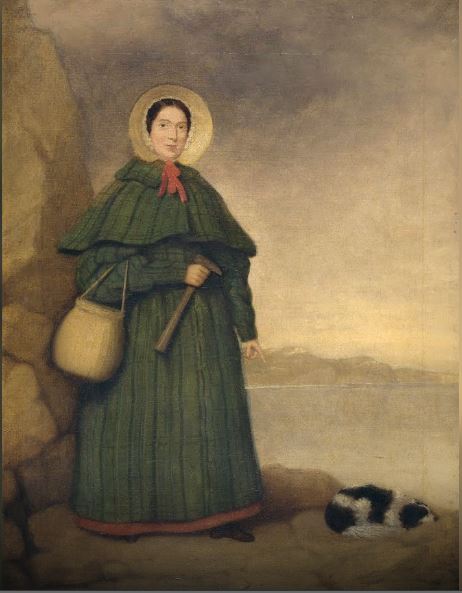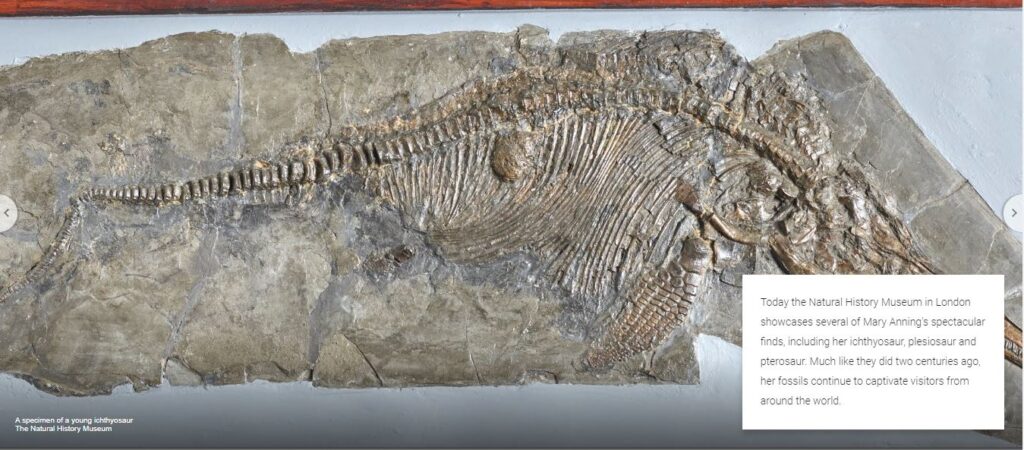
Although the concept of virtual museum exhibits is one with which I am familiar (thanks to previous courses and the Google Arts and Culture app), I had never paused to reflect on the very nature of these projects. Previously, my focus was directed towards the ability to casually peruse different museums from the comfort of my couch during the pandemic; however, this assignment really made me reflect upon the digitization of museum exhibits and their effectiveness.
The digital exhibit that I explored was “Mary Anning: History’s Pioneer of Palaeontology” presented by The Natural History Museum in London, England. This presentation centered around Mary Anning, one of the first paleontologists of the early 1800s; she made many key discoveries along what is colloquially known as the Jurassic Coast, where even nowadays important fossils are uncovered. While it is difficult to pinpoint the exact audience for this exhibit, it can be assumed that it is geared towards those interested in dinosaurs and other fossils. The content pairs these artifacts and a geographic location familiar to those knowledgeable in paleontology with a somewhat lesser-known figure who made a significant impact on the shaping of the science.
Because of relatively new and unprecedented protocols implemented throughout society, virtual exhibits such as this one on Mary Anning are important for museums to continue cultivating interest and public support. Although there are quite a few shortcomings with this new medium, the accessibility of exhibits is a major advantage of digitizing entire exhibits. I would have never been able to experience this Mary Anning project had it not been for The Natural History Museum’s partnership with Google Arts and Culture to bring about a virtual tour; I had neither the money or proximity to visit the museum in person, and thus, I am very appreciative of their willingness to share via a channel lacking profit. The added benefit of seeing the displays and captions deemed important by creators is something that could be considered both a positive and negative effect of digital exhibits. As someone who has frequented her share of museums and has always insisted upon reading EVERY piece of writing within the place, having a specifically curated and concise presentation reduces the intimidation that can be produced by entering museum halls. Although this limits the scope of what could be a rather large collection and exhibit, it also counteracts the ability to overwhelm and makes the material more approachable because of that. The material on display also determines the quality of the virtual museum exhibit; if the artifacts do not transfer well into digital media, the collection’s impact will be lesser and could even dictate opinion of the museum or topic. The fossils used within the presentation to illustrate the critical work Anning did were not as impressive in the slideshow that comprised the exhibit; the size of the extinct creatures was not conveyed in the pictures as well as it would have been in person.

All of this being said, I thoroughly enjoyed exploring this exhibit and wish I could engage with it in person rather than purely through a website and app. I appreciate the expansion of digitization as a feasible way to attract “visitors” to the museum and think that it will be especially important given the current social climate in which we are living. There will always be features that do not translate well, but more often than not, I feel as though collections could be successfully shared with the public through the internet.